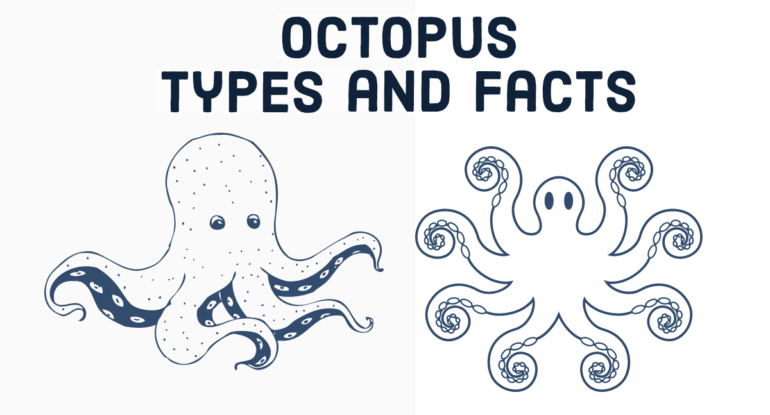Octopus Introduction
Octopus is marine cephalopod can be identified with their eight arms. The Octopus belongs to Cephalopods family. They are found in all marine habitats that range from tropical reefs to polar latitudes. they are an ecologically significant species. They are voracious predators, strictly carnivorous and an important prey item being a source of protein for fish as well as marine mammals, too.
Approximately 300 species of octopus can be found in oceans throughout the world. While there are two species of UK octopus found in south and west coasts of the UK. The curled octopus UK and Common Octopus.
A majority of octopuses live on the ocean floor, some species can be found living closer to the ocean’s surface. Most Octopus use their arms to catch prey, like crab, shrimp and mollusks.
Octopus Information Guide
Scientific name
Octopus vulgaris
Common name
Octopus
Family
Cephalopods
Diet
Carnivore
Size
Maximum length 20 – 30cm and arm-span of around one metre.
Shape
A large octopus with a bag-like body and 8 long arms, each with 2 rows of suckers. Body is warty and changes colour depending on the environment and its mood, though it normally appears brownish-green.
Habitats
Marine water and oceanic sea
Distribution of UK Octopus
Most common on south and west coasts of the UK
Time to see
January to December
Behaviour
Cephalopods are not just capable of changing colour but also altering its texture. The ability of octopuses to use suckers to feel and grasp food demonstrates that it is conscious and has a subjective. Octopuses are prone to bipedal movement.
Intelligence
The octopus, also known as marine animal that has an oblong, soft body that has eight flexible arms around its base. The Octopus is an invertebrate which means it doesn’t have an backbone.
The neurons are located within the arms of an octopus, and each arm contains between 200-300 suckers as well as a network of nerves that regulate local movements and collects sensory data. In both ocean and laboratory environments, the octopus is well-known for its ability as a spotting animal.
Types Of UK Octopus
There are two types of UK Octopus which are found along UK Coastline.
1- Common UK Octopus
The Common Octopus is found all over the world in tropical, semi tropical and temperate waters from shore shallows to 200 meters in depth. Common UK Octopus has been an increase in sightings in Cornwall, especially around the Lizard peninsula. Oher then that, Common Octopus UK is found around all coasts of the UK, more common on south and west coasts.
It is considered to be one of the most intelligent invertebrates. Common UK Octopus have no bones in their bodies, and every part of an octopus is soft except for its hard, beak-shaped mouth. Common octopus has a global and widespread distribution. The skin of the Common Octopus UK is smooth, which is quite unusual for Octopuses.
The Common UK Octopus is known for its huge eyes, soft body, and tentacles. The octopus can reach up to a metre which is about three feet. It is extremely clever and a keen predator. The common octopus has arms with numerous suckers on each one. It uses its suckers to move around and to grasp animals when it hunts.
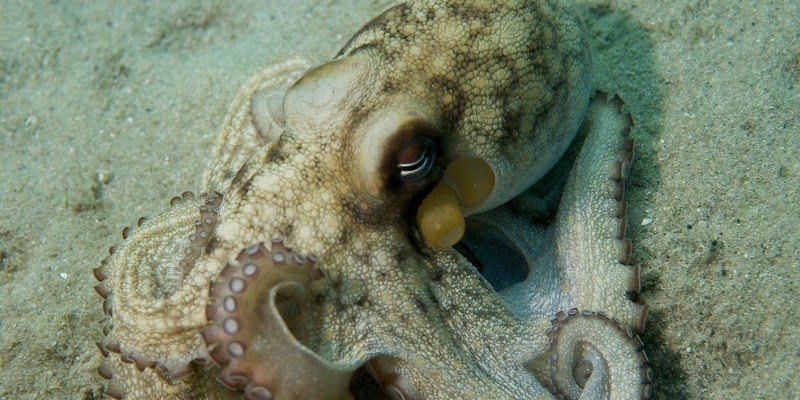
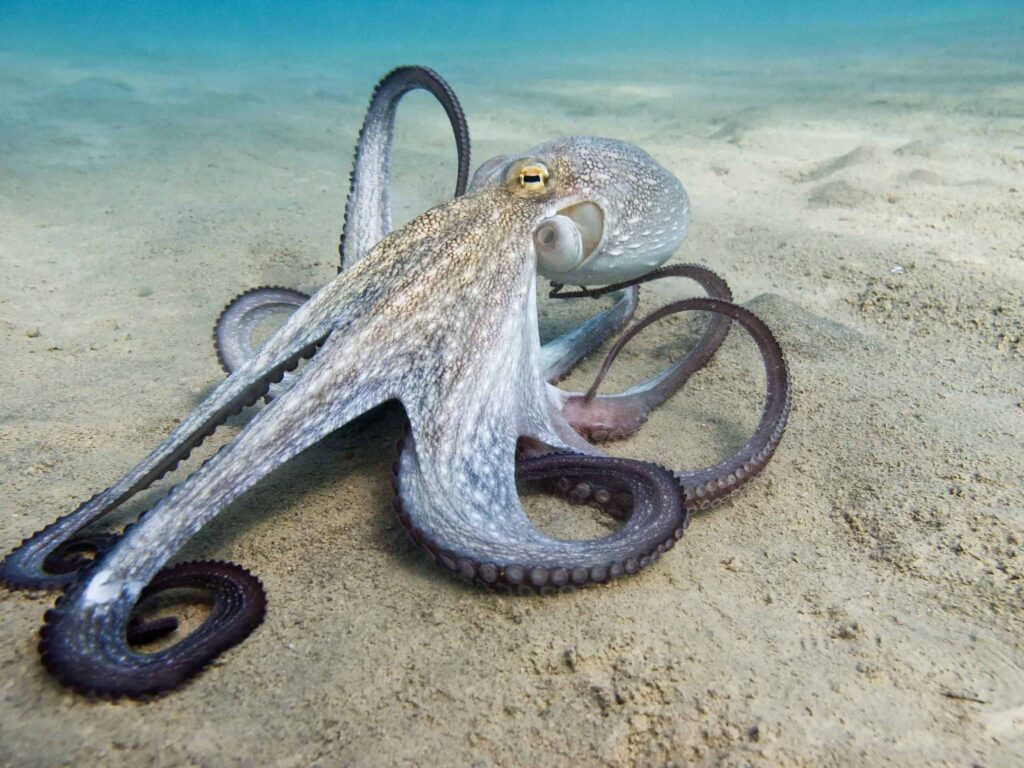
2- Curled Octopus UK
The curled octopus, called the lesser octopus, horned octopus and northern octopus. The Curled UK Octopus can be found in between the 10 to 150 meters deep, with some instances going as low as 800 meters throughout British and Irish coasts. They spends the majority of the day hidden between the rocks and in crevices.
Curled UK Octopus can grow up to 50 cm in length and has a smooth or very tuberculate body. It curls its tentacles during rest. The head is small, oval and slim. The arms are slim that are finely tapered distally, and curled in rest, and have one line of suckers. The massive mantle is spread between eight arms that are long and slim. The color of curled UK octopus is mostly red-brown but some species can alter colour rapidly to match their background.
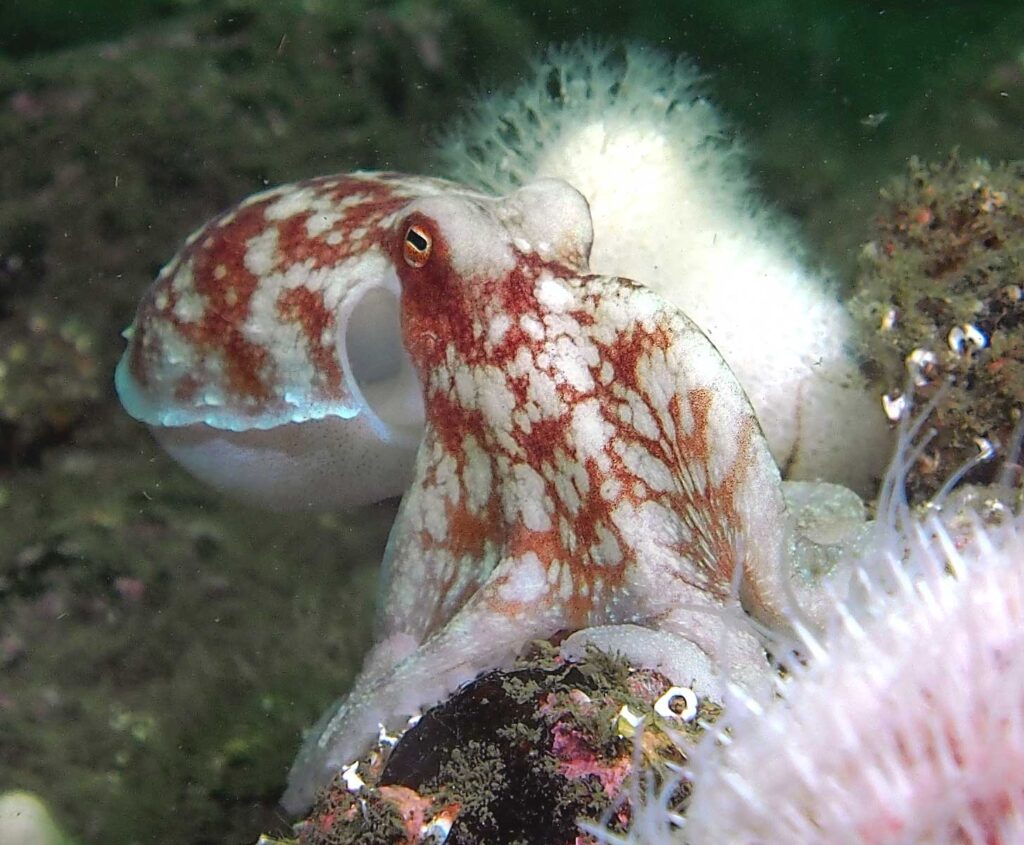
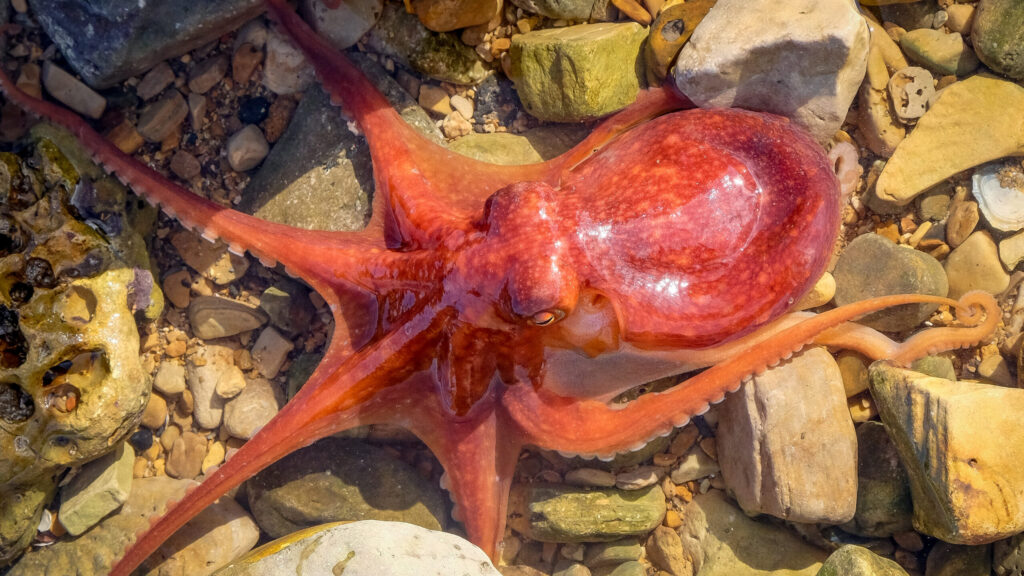
18 Types of Octopus found different parts of the world
Here are the short detail of common Octopus which found in different parts of the world.
1- Flapjack Octopus
These octopuses are identified by the webbing that is between their arms, which causes them to assume an umbrella-like shape while they swim, particularly when they are floating in the water.
2- Star-sucker Pygmy Octopus
The tiny octopuses were first discovered on the Western Pacific ocean in 1913. They’re usually an orange-colored sandy color with cute arms that are lined by tiny suckers. They are affixed to shallow water, ranging from 2 (0.61 meters) up to 90 feet (27.4 meters) deep. They are known to hunt for small mollusks as well as other crustaceans.
3- East Pacific Red Octopus
The species was first discovered in the mid-1800s their official taxonomy remains unsolved. Scientists continue to study and classify octopuses they think that this species could eventually be part of an octopus species complex or subspecies of another species of octopus. The colour and the habitat has been the reason for their name, but they’re also called “red octopus.” These species of octopus are deep-sea feeders.
4- Atlantic Pygmy Octopus
The smallest octopus found in oceans is known as that of the Atlantic Pygmy or Dwarf Octopus. They are just five and a half inches (13.9 cm) in length, and three of the inches (7.6 centimeters) is their tentacles. The majority of adult animals of this breed weigh just one kilogram.
The octopuses of the sea are great for hiding from predators. They collect things such as shells and clamshells, then tuck them in the sand, creating an area to hide.
5- Lillliput Longarm Octopus
The octopuses are described as “the Atlantic Longarm Octopus. While they’re a tiny species of octopus, they possess enormously long arms that reach far beyond the usual length of two times the height of the head. They’ve been observed across areas like the Caribbean, Indian Ocean, and in the Mediterranean Sea.
6- Caribbean Reef Octopus
They Caribbean Reef Octopus get their name from their habitat of choice and the coral reefs that they live on for their dens. As more reefs are destroyed due to warming waters and the loss of their habitats. The octopuses are one of the species with shorter lives with a lifespan of 10 to 12-months in wild.
7- Hammer Octopus
They have arms that are long with thin tips that are slender at the ends to help them move more easily however, they are mostly used to aid the animals reproduce. The Hammer Octopus is found in eastern Australia’s subtropical waters that runs all the way from Queensland from Queensland to New South Wales.
8- Common Blanket Octopus
The Blanket Octopus’s name comes because of the transparent webbing which connects their dorsolateral and dorsal arms on females. They use the blankets whenever they feel threatened and release them into the water to expand their size dramatically.
9- Coconut Octopus
This Coconut Octopus is another amazing species of Octopus. They stroll on the ocean floor on two legs, while using the other legs for carrying a coconut on their heads. The motion is created when a predator is looking at it from the sky makes it appear that the coconut shell is being moved by waves.
10- Dumbo Octopus
It is the Dumbo Octopus is one of the most famous Cirrina Octopus species. They are deep-sea creatures like many other species belong to this suborder. They are comparatively tiny, with a height of 8 inches (20.32 centimetres) tall.
Dumbo Octopus UK are characterized by the flaring fins along their bodies, which give them the appearance of have massive ears, like the elephant featured in the 1941 Disney film.
11- Seven-Arm Octopus
This kind of Octopus is one of the largest species in the world, however, it’s not as large as that of Giant Pacific. The largest size of these octopuses is believed to be around 11 feet (3.4 meters) and they could weigh as much as 165 pounds (74.8 kilograms).
12- Giant Pacific Octopus
Giant Pacific Octopus is one of the largest ocean octopuses by quite a lot. It is noted that the Guinness Book of World Records includes the largest of these creatures weighing 300 pounds (136.1 kg) but there’s been reports of one that weighs around 600 pounds (272.2 kg) with an arm length that was around 30 feet (9.1 meters).
13- Mimic Octopus
The Mimic Octopus is an incredibly distinctive octopus that has the capability to conceal it better than nearly every other Octopus. They sport white and brown stripes that are affix to the entire body. By combining these patterns and colours they can expand their arms, and alter the shape of their bodies to impersonate dangerous marine creatures.
14- Southern Blue-Ringed Octopus
They are tiny and range in size between 0.15 inch (0.38 cm) up to 7.9 inch (20.1 cm). They range from light brown to yellow, often appearing more tan.
The pattern of the smaller octopuses is like the larger blue-ringe Octopus. The eyespots are blue throughout their bodies, each of which produce saliva venomous.
15- Greater Blue-Ringed Octopus
This Greater Blue-Ringed octopus is thought to be the most poisonous of all the marine creatures. The rings appear to shine when the octopus gets angered, and act as a warning hue. Instead of producing ink like other octopuses this species produces an ointment that is mixed with tetrodotoxin like the poisonous pufferfish.
16- Capricorn Octopus
Capricorn octopuses sleep at night they only emerge at night to search to find food. They venture out of caves and crevices, and then into the deep waters of Australia, in order to face less competition than in the daytime. It is their characteristic of hunting in the night that earns them the name “night octopuses.”
17- Sandbird Octopus
Sandbird Octopus Sandbird Octopus is native to the Indo-West Pacific oceans in Mozambique as well as in the Red Sea, and around Japan. They are often hunt for food and then brought back to be use in traditional meals. They get their name due to the fact that they reside in shallow, sandy and muddy holes similar to sandbirds within their region.
18- Algae Octopus
The Algae Octopus gets its nickname because of its camouflaged body when in hiding or hunting. It is the shell of the gastropod that is overgrown with algae and sat on the bottom of the ocean throughout the. Octopuses are small.
Octopus Interesting facts
1- Octopuses have three hearts
Two of the hearts are designed to transport blood outside the animal’s gills, and the third helps to maintain circulation for organs. The organ heart ceases in the event that an swimming octopus enters the water, which is the reason for its preference to crawl rather than swim that exhausts the heart.
2- Octopuses are old Species
The oldest known Octopus fossil is one that was alive around two million years back in the Carboniferous period. The fossil is part of a species called Pohlsepia which is displayed in the Field Museum in Chicago.
3- The plural of the octopus is called the octopuses
The world “octopus” is derived from Greek, okt opus which means “eight foot.” The word’s Greek roots indicate that the word is pluralized as it’s a Greek word also, which is dependent on the gender of a noun and the final letter it is ending with. In this instance, the”-es” is just a tack onto.
4- Aristotle thought octopuses were stupid
In his history of Animals, published in the year 350 BC The Greek philosopher wrote “The octopus is a stupid creature, for it will approach a man’s hand if it be lowered in the water but it is neat and thrifty in its habits.
5- Octopus arms have an independent mind
Two-thirds of an Octopus’s brain cells are in its arms, not in its head. Because of this, arms are able to figure out opening the shellfish, even when their owners are engaged in other things, such as searching for additional food items. Arms can also react after having been totally severed. In one study severed arms moved away in pain as researchers pounded the limbs.
6- Octopus ink physically harm
The ink can also physically harm the enemies. It is a chemical known as Tyrosinase that is found in humans and helps in controlling the production of melanin, a natural pigment. When sprayed on the eyes of predators, tyrosinase triggers a painful and blinding irritation.
7- Octopuses have blue blood
To survive in deep oceans in the deep ocean, octopuses have evolved to have a copper-based blood, known as hemocyanin which makes their blood blue. Copper is more effective at carrying oxygen, and is more effective than haemoglobin in situations where temperatures are low and no oxygen is present. This system can cause the octopuses to be extremely susceptible to variations in pH.
8- Octopuses Mating and parenthood
Mating and parenthood are not long-lasting for octopuses. They die soon after. The species practice external fertilization. Males can either put their spermatophores into an elongated funnel which the female uses to breathe, or simply hand her the sperm that she will always accept with one of her arms. Then, males go off to die. Females are the same. they can lay as high as 400 000 eggs that they constantly guard and tend to.
The first farm in the world for octopuses
The first farm for octopuses are found in Spain in researchers from the Spanish Oceanographic Institute. There they examined the breeding behaviours that occur in The Common Octopus. A 52,000 square meter aquaculture farm, capable of producing nearly 3,000 tons of octopus per year on the Canary Islands.
Octopus Conclusion
The Giant Pacific Octopus is the largest octopus species in the world. An octopus has been construct completely differently and has three hearts as well as a brain wrapped over its neck, as well as a coat of slime, not hair. A octopus’ beak that is use to crush food items like crabs and molluscs to consume.
A Strong, flexible and smart UK Octopus is a snazzy model for a completely different kind of multi-armed, multi-talented robot. Additionally, the octopus comes with eight arms and three hearts, as well as the blue color of their blood.
Octopus FAQs
Q1. What is the scientific name of octopus?
The scientific name of octopus is Octopus vulgaris.
Q2. Are UK octopus are intelligent?
Yes they are suppose to be intelligent. But Aristotle thought octopuses were stupid they quickly grab in human hand.
Q3. Where does octopus live?
Octopus usually lives in oceanic and marine water.
Q4. Does UK octopus are dangerous?
Some of them are deadly dangerous but most of them are human friendly and few of them are edible too.
Q5. How many heart octopus have?
The octopus have three heart. The Two of the hearts are design to transport blood and the third helps to maintain circulation for organs.

